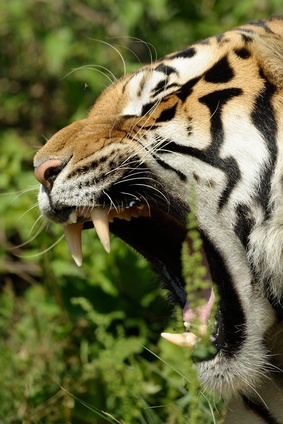June 17, 2014  Have
you ever heard a lion roar at close range? Have
you ever heard a lion roar at close range?
The first time I did, I was in a car a few feet away from a magnificent male with a huge, shaggy mane. The sound that issued from his throat was seemingly effortless, astoundingly loud (about 112 decibels), and had the uncomfortable effect of convincing me that I was not only about to be prey, but that I should start to pray (and the sooner the better)! A few years later, I had a similar spine-tingling experience when I visited the studio of a sound engineer who was trying to create a credible dragon’s roar for a feature-length fantasy film. His formula? Mix a female tiger’s roar with the rhythmic chop of Huey helicopter blades. The combination produced a deep and terrifying rumble that evoked primal fear in audiences everywhere. (It also was weirdly disturbing to my Vietnam vet friends. But that’s another story.) IMPLICATIONS TO HUMAN HEALTH Extreme vocalizations, like the roars of big cats, hold clues for scientists hoping to unlock the mysteries of human vocal health. That is why, back in 2011, the National Institutes of Health and the National Science Foundation funded research to determine how lions and tigers produce such loud, deep sound. Three lions and three tigers at the Henry Doorly Zoo in Omaha that had succumbed to disease were the research subjects. The team soon discovered that the reason that lions and tigers are capable of such amazing vocalizations is that they have flat, square vocal folds that can withstand a lot of stretching. This is a marked contrast to the V-shaped vocal folds of other mammals. FAT IN THEIR FOLDS Lions and tigers also have fat located deep within their vocal fold ligaments. Scientists postulate that this fat helps cushion the cats’ vocal cords and provide material for repair if the folds are damaged. Speech scientist Ingo Titze, executive director of the National Center for Voice and Speech and a member of the team that conducted the research, commented that this shape "makes it easier for the tissue to respond to the passing airflow," allowing louder roars with less lung pressure. The folds vibrate side to side, and up and down. LOUDER THAN LAWN MOWER The team was also able to estimate the big cats’ maximum variations in volume at 10 to 430 hertz (or cycles per second). Compare this to average human vocal ranges of:
"We study a lot of animals - deer, elk, dogs and cats," says study co-author Tobias Riede, a research assistant professor of biology at the University of Utah and a research associate at the National Center for Voice and Speech. "Lions and tigers are just interesting examples for very loud and low-frequency vocalization." By contrast, an enormous bull elk’s high-pitched shriek measures 2,500 hertz even though its vocal folds are roughly the same size as lions’ and tigers’. HAVE VOCAL STRAIN? Before this study, biologists assumed that lions and tigers must have been capable of low frequencies because of the mass and weight of their vocal folds. The news that the shape and elasticity of these tissues plays such a fundamental role has implications for human health. Anyone subject to vocal strain may benefit – teachers raising their voices over noisy classrooms, coaches calling to players in the field, and cancer patients recovering from surgery – to name a few. (Audiobook voice actors, and other long-form narrators, take note.) "If you understand how vocal folds are structured and what effects that structure has on vocal production, then it could help doctors make decisions on how to reconstruct damaged vocal fold tissue" Riede says. And that's a hopeful sign for those of us who speak for a living. For more on breakthroughs in vocal cord reconstruction, please see Sounds Odd # 6 – New Hope For Damaged Vocal Cords.------------------------------------------------  ABOUT ELIZABETH ABOUT ELIZABETHElizabeth Holmes is a writer, voice actor, and staff editor at VoiceOverXtra, based in Northern California. She is also editor of VoiceOverXtra's book division, including Voice Over Legal, by voice actor / attorney Robert Sciglimpaglia. Email: elizabeth@HolmesVoice.com Earlier Sounds Odd Columns: http://bit.ly/SoundsOddColumns |
|
|
|
Tell Us What YOU Think!
Please Note: Since we check for spam, there will be a slight delay in the actual posting of your comment.
Comments (1)
Rebecca aka LoveThatRebecca
6/17/2014 at 5:47 AM
SO COOL Elizabeth! Not only are lions and tigers some of my favorite cats, but now they are contributing to human vocal health. Totally amazing this occurs. Thanks for sharing.

 SOUNDS ODD #25
SOUNDS ODD #25
.png)




.gif)


click for new article alerts